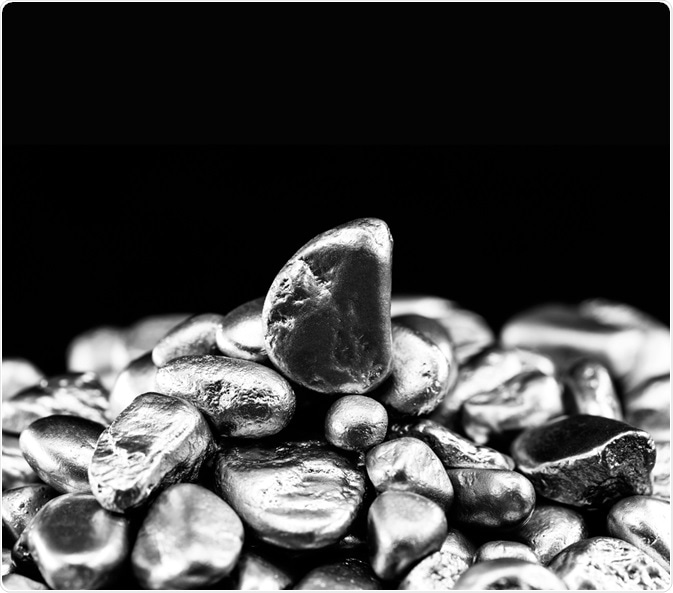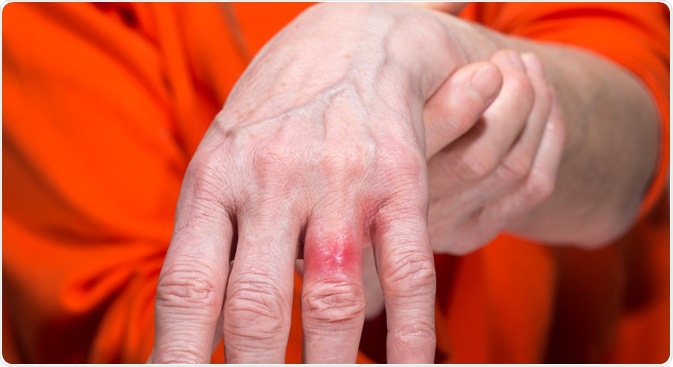Nickel or nickel sulfate hexahydrate is a common allergen that causes contact dermatitis in sensitized individuals. Nickel is a chemical that is widely used in utensils, jewelry, coins, metal buttons, eyeglasses, paper clips, keys, enamel dyes, and electrical wiring.

Image Credit: RHJPhotoandilustration / Shutterstock.com
Nickel sulfate hexahydrate is also known by other names such as blue salt, nickel monosulfate hexahydrate, and single nickel salt. The American Contact Dermatitis Society declared nickel as the Contact Allergen of the Year 2008.
Symptoms of a nickel allergy
Individuals who are allergic to nickel develop various reactions upon exposure to this chemical. Common symptoms of nickel sulfate hexahydrate include erythema, scaling, vesicles, pruritus, and dermatitis or eczema in parts of the skin that comes into contact with nickel. The affected areas are severely itchy and red with blisters or pigments.
The most common sites for dermatitis triggered by a nickel allergy include:
- Wrists, as a result of watch straps or bracelets that contain nickel
- Earlobes, as a result of nickel-containing earrings
- Lower abdomen, as a result of the studs in jeans containing nickel

Image Credit: Rainer Furhmann / Shutterstock.com
Systemic responses can also result from dietary ingestion of nickel. Dietary nickel consumption will cause pompholyx in individuals with a nickel allergy, which is a type of eczema that causes irritation and blisters on the hands and feet.
Who is susceptible to a nickel allergy?
Males and females of any age can develop a nickel allergy and, once developed, this allergy can persist long term. Nickel allergies are more common in females due to the increased use of nickel-containing jewelry and piercings by women.
The degree of the reaction varies across individuals. In some people, even brief contact with nickel-containing products causes dermatitis, whereas others will require several years of contact with nickel to trigger a reaction.
Diagnosis and treatment of a nickel allergy
A nickel allergy is diagnosed with the help of allergy patch tests and obtaining a clinical history of the affected person. Nickel dermatitis often requires treatment using diluted vinegar compresses for drying up blisters.
Topical steroids can be applied to the area affected by dermatitis. Dry, itchy skin is often treated with emollient creams. Antibiotics are prescribed in cases of secondary infection due to nickel dermatitis.
Patients with a high degree of nickel allergy are usually prescribed a diet low in nickel-containing foods. Processed and canned foods should generally be avoided.
Most vegetables, meat, eggs, fish, cereals, and dairy products are safe for nickel-sensitive people. This is, however, complicated, as the nickel concentration in a given fruit might vary in different regions. Due to the ubiquitous nature of nickel and its incorporation into faucet fixtures and cookware, those with a nickel allergy should practice caution, as nickel can potentially leach into the water and foods while using these products.
As with any condition, prevention is better in the case of a nickel allergy. Allergic individuals can avoid any skin contact with nickel by stopping the use of nickel-containing metals in pieces of jewelry such as necklaces, bracelets, earrings, rings, and watch straps. Those with this allergy should also be made aware of nickel-containing clothing parts such as metal zips, hooks, and buttons.
Nickel can also be present in other personal items such as mobile phones, handbags, keys, cigarette lighters, and pens. Those with a nickel allergy should therefore choose items made of alternative metals or plastic instead.
Nickel allergy: How to avoid exposure and reduce symptoms
Dietary nickel
Nickel ingestion through the diet in nickel-sensitive people triggers a series of changes in the immune system that can lead to the development of clinical reactions. Nickel ingestion causes a decrease in circulating CD8+, CD45RO+, and CLA+ blood lymphocytes, which can lead to the migration of CD8+ memory T cells into the tissues.
Dietary ingestion of nickel also increases interleukin (IL)-5 levels in the serum. As a result, there is a rapid increase in the reproduction of eosinophils, which are white bloods cells that help fight allergies and infections.
The mechanism of absorption of ingested nickel in the body is not fully understood yet, though it has been proved that vitamin C and iron are capable of decreasing the absorption of dietary nickel. Therefore, iron-rich foods and vitamin C supplements can help reduce the amount of nickel absorbed by the body.
References
Further Reading
Last Updated: May 22, 2021